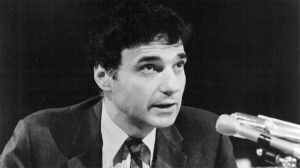
Ralph Nader testifies before Congress in 1966. It was 50 years ago this week that his groundbreaking book, "Unsafe at Any Speed," was published.
For decades, conventional wisdom in the auto industry held that “safety doesn’t sell.” And that certainly appeared to be the case when an unknown Washington attorney began looking into reports of problems with the then-popular Chevrolet Corvair.
What Ralph Nader uncovered led to the publication of the groundbreaking book, “Unsafe at Any Speed,” 50 years ago this week. And it resulted in a major shift in thinking by both the American public and the auto industry that has led to significant improvements in vehicle safety and a huge decline in highway fatalities.
As many 3.5 million Americans would have been killed over the past half-century had Nader’s muckraking work not led to the passage of the first highway safety laws and the dramatic changes in vehicle design and technology that followed, according to a new study by the Center for Auto Safety.
“The book was one of the most instrumental ever published in terms of public policy,” says Joan Claybrook, former administrator of the National Highway Traffic Safety Administration and a still active advocate for vehicle safety.
“Unsafe at Any Speed” might have had only a marginal impact if not for the over-reaction by General Motors, which hired private detectives to investigate Nader, recalls Claybrook, adding that “All hell broke loose” when that was revealed. It turned Nader into “a national figure and, within nine months propelled the legislation,” the nation’s first auto safety bill drafted by the Johnson Administration.
Despite the industry’s conventional wisdom, consumers really were long concerned about vehicle safety, contends Adrian Lund, the director of the Insurance Institute for Highway Safety. The problem was that there was really no place to get objective information.
“Everybody was claiming their cars were safe, but there was no objective third-party to actually say who was building a safer car,” says Lund.
The new laws changed that. The bill led to the creation of both the U.S. Department of Transportation and the National Highway Traffic Safety Administration. It authorized the creation of new rules meant to set vehicle standards and, subsequently, to test and compare vehicles.
Traffic deaths totaled 50,894 the year Nader’s book went to press. But as the new rules went into effect, and newer vehicles — designed to both prevent crashes and ensure the safety occupants in the event of a collision – became more commonplace, the toll began to tumble.
In 1966, 5.50 Americans were killed for every 100 million miles traveled. Last year, the death rate was 1.07. At the higher figure, 167,956 people would have been killed on U.S. roads. Instead, the number was 32,675.
Even that number is too high, contends Mark Rosekind, who became NHTSA’s newest administrator a year ago this month. And, troubling advocates, the raw fatality numbers actually rose 8% during the first half of 2015, though Americans have been clocking a lot more miles as fuel prices have plunged and the economy has gone into recovery.
(Ford captures 2016 Green Truck of the Year with F-150. For more, Click Here.)
Nonetheless, “These numbers are a wake-up call,” said Rosekind last week. And he and other advocates point to a series of recent problems, such as the General Motors ignition switch scandal and the ongoing recall of nearly 20 million vehicles equipped with defective Takata airbags, that show vehicle safety can’t be taken for granted.
When “Unsafe at Any Speed” was published, it would have seemed hard to imagine that the U.S. highway death toll could drop even as much as it has, but despite the recent upturn, many safety proponents believe there’s opportunity for even greater improvements ahead. Both Nissan and Volvo have, for example, set a goal of achieving zero deaths in their new vehicles come the next decade.
They expect major breakthroughs to come through a new generation of digitally controlled active safety technologies. IIHS director Lund calls electronic stability control the single most important safety feature since the seatbelt. A growing number of vehicles now come with features such as blind spot detection and forward collision warning. And the first fully autonomous vehicles could be on the road by 2020 or soon afterwards.
(For more on the Volt’s Green Car win, Click Here.)
But not everyone welcomes this technological rush. In an interview with Automotive News, Nader warns that carmakers may be “turning the automobile into an ever more complicated computer on wheels. Which means that the driver is losing control to the software, and the more the driver loses control to the software, the less the driver is going to be able to control the car down the road.”
Nader disciple Claybrook takes that warning seriously, as do others who question whether autonomous vehicles are really the promised panacea. Others, including NHTSA Administrator Rosekind, stress that 94% of today’s highway fatalities are due to driver error, and suggest it may be time to let smart cars take control.
The debate over how to improve highway safety is far from over. But one thing is clear: there’s no going back. In fact, consumers may be driving things more than federal regulators. Safety has become one of the single most important considerations for today’s car buyers, says Mark Reuss, GM’s director of global product development.
(Hydrogen cars are just a dodge, declares top Tesla exec. Click Here for the story.
A half century after the publication of “Unsafe at Any Speed,” it seems, the new industry mantra is that “safety does sell.”


History shows that Nader was complete wrong in many of his allegations, in particular the Corvair which was no more dangerous than any other rear engine car that oversteers by design. The fact the most Americans back then and still toady… lacked actual driving skills allowed Nader to dupe the gullible. Even with those “dangerous Corvairs” off the roadways, people continue to kill each other daily at a rate of ~90 deaths on average per day in the U.S.
When you do the math, with hugely more vehicles on the road driving massively more miles every year, the reality is that the death rate has plunged 80% on a per-100-million-miles-traveled basis, a legitimate measurement tool. And on a raw basis, the number is still down by nearly half from the peak set around the time Unsafe was published.
Nader arguably got a number of things wrong…but he was directionally correct. The auto industry did not make safety anywhere near its top priority. Dashboards were hard metal, steering wheels had a tendency to spear drivers in a crash, and vehicles had no energy-absorbing elements to their design. As recently as the late 1980s, perhaps even into the 1990s, I would hear industry officials defend — on the record — decisions by saying safety was not a priority with the public. Were it not for the standards set as a result of the laws passed following Nader’s muckraking I believe it would have taken a lot longer to see things change.
Was Nader right on all points? No. But can you name an industry executive whose decisions are routinely right on all counts? Nader changed the topic of the discussion and millions of Americans — whether they like his politics or personality — owe him a debt of gratitude.
Paul A. Eisenstein
Publisher, TheDetroitBureau.com
Sorry but I do not find Nader a savior of society for his knee-jerk reactions and incorrect technical conclusions. Like most siren chasers, he was able to deceive a lot of people for profit. He did at least as much damage to society as good, IMNHO.
It’s no longer the cars unsafe at any speed, it’s the drivers. Last night some idiot passed me at 20 mph above the speed limit, cut in front of me, passed another car on the right and cut in front of that car and continue down the road.
I caught up with that idiot at the next traffic light.
And there is entirely too much “going on” in the instrument panels. Too many distractions to take your mind away from driving.
Lois
Nobody wants to correct the situation with irrational or incompetent drivers. Instead the politicians believe they can use auto electronics to compensate for the seriously dangerous drivers.